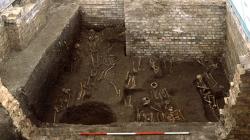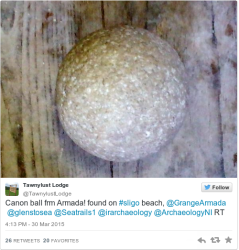INSTITUT SUPERIEUR D'ANTHROPOLOGIE
INSTITUTE OF ANTHROPOLOGY
ONLINE COURSES / COURS A DISTANCE
SPRING TERM : APRIL 2015
REGISTER NOW
HONGRIE –  Szigetvar - The location where the internal organs of 16th century Ottoman Sultan Süleyman the Magnificent were buried has been discovered in southern Hungary. The sultan died in 1566 during the siege of the Szigetvar Fortress. An official of the fortress, Janos Lebedi, said excavations to find the organs have been ongoing for two years in 18 spots around Szigetvar, but now the search has been narrowed down to just one spot. The suspected resting place of the organs is a vineyard in the city’s highest spot, seven kilometers away from the Szigetvar Fortress. Lebedi said an excavation had already been conducted in the 40-meter-long and 10-meter-wide vineyard in 1972. During this excavation, three Ottoman structures were found as well as Ottoman roof tiles, pottery and green ceramics. “The communist regime of the time, which carried out the excavations, kept it a secret. But these findings can be seen in every part of the vineyard. The archived documents also show that there was an Ottoman bastion here, stating that the internal organs of Sultan Süleyman were buried there. Historical sources record that Sultan Süleyman’s body was temporarily mummified and buried under his bed at his imperial tent near the fortress, after his heart and internal organs were removed for the mummifying process. The body was then transferred to Istanbul, while the organs remained in Hungary.A shrine built by Sultan Selim II at the site of his father’s temporary tomb in 1577 was plundered and demolished by the invading Austrians in 1693, leading to the current confusion about its whereabouts.
Szigetvar - The location where the internal organs of 16th century Ottoman Sultan Süleyman the Magnificent were buried has been discovered in southern Hungary. The sultan died in 1566 during the siege of the Szigetvar Fortress. An official of the fortress, Janos Lebedi, said excavations to find the organs have been ongoing for two years in 18 spots around Szigetvar, but now the search has been narrowed down to just one spot. The suspected resting place of the organs is a vineyard in the city’s highest spot, seven kilometers away from the Szigetvar Fortress. Lebedi said an excavation had already been conducted in the 40-meter-long and 10-meter-wide vineyard in 1972. During this excavation, three Ottoman structures were found as well as Ottoman roof tiles, pottery and green ceramics. “The communist regime of the time, which carried out the excavations, kept it a secret. But these findings can be seen in every part of the vineyard. The archived documents also show that there was an Ottoman bastion here, stating that the internal organs of Sultan Süleyman were buried there. Historical sources record that Sultan Süleyman’s body was temporarily mummified and buried under his bed at his imperial tent near the fortress, after his heart and internal organs were removed for the mummifying process. The body was then transferred to Istanbul, while the organs remained in Hungary.A shrine built by Sultan Selim II at the site of his father’s temporary tomb in 1577 was plundered and demolished by the invading Austrians in 1693, leading to the current confusion about its whereabouts.
http://www.hurriyetdailynews.com/resting-place-of-suleyman-the-magnificents-organs-reportedly-found-in-hungary.aspx?pageID=238&nID=80450&NewsCatID=375
ROYAUME UNI –  Cambridge - One of the largest medieval hospital cemeteries ever discovered in Britain, filled with the remains of more than 1,000 people, has been discovered beneath a Cambridge University college. The burial ground, which has lain hidden for centuries, once stood on the site of what is now St John’s College in Cambridge. It was unearthed during refurbishment work three years ago. While the existence of the cemetery has been known to historians since the mid-20th century, it has only now been made public. The cemetery dates back to around the 13th century. During a six-month dig, a team of 20 archaeologists tunneled their way through the college floors, unearthing the remains of 1,300 people, including 400 complete skeletons. They are thought to be patients of a medieval hospital that stood opposite the graveyard until 1511. The cemetery appeared to “serve the poor,” as the dead were buried without coffins, some even without shrouds. Very few of the bodies belonged to women and children, as the site’s “main purpose was to cater for poor scholars and other wretched persons.”Experts say an on-going DNA analysis of the remains will help cast light on life and death in medieval Britain.
Cambridge - One of the largest medieval hospital cemeteries ever discovered in Britain, filled with the remains of more than 1,000 people, has been discovered beneath a Cambridge University college. The burial ground, which has lain hidden for centuries, once stood on the site of what is now St John’s College in Cambridge. It was unearthed during refurbishment work three years ago. While the existence of the cemetery has been known to historians since the mid-20th century, it has only now been made public. The cemetery dates back to around the 13th century. During a six-month dig, a team of 20 archaeologists tunneled their way through the college floors, unearthing the remains of 1,300 people, including 400 complete skeletons. They are thought to be patients of a medieval hospital that stood opposite the graveyard until 1511. The cemetery appeared to “serve the poor,” as the dead were buried without coffins, some even without shrouds. Very few of the bodies belonged to women and children, as the site’s “main purpose was to cater for poor scholars and other wretched persons.”Experts say an on-going DNA analysis of the remains will help cast light on life and death in medieval Britain.
http://rt.com/uk/245917-medieval-cemetery-discovered-cambridge/
ROYAUME UNI –  Runcorn - Norton Priory in Runcorn has teamed up with the University Of Liverpool to develop a carbon dating technique that is predicted to revolutionise field archaeology. It is the hoped the pioneering dating technique will reduce the wait for results from more than six weeks to two days, all for a lower cost than traditional methods. A Norton Priory spokeswoman said radiocarbon dating is one of the most important techniques used by archaeologists to find out the age of organic samples, but is expensive and takes place off-site leading to lengthy lengthy times hanging on for findings to be provided. This means that an excavation is likely to be over before the dating information can be obtained. But the ground-breaking work Liverpool University's electronic engineering and electronics department is expected to slash this period, for bone, to two days. This means that carbon dating can take place on-site while a dig is ongoing. Norton Priory Museum And Gardens provided medieval and post-medieval animal bone samples, already dated, for the university scientists to analyse with prototype technology, which is a form of quadruple mass spectrometer (QMS).
Runcorn - Norton Priory in Runcorn has teamed up with the University Of Liverpool to develop a carbon dating technique that is predicted to revolutionise field archaeology. It is the hoped the pioneering dating technique will reduce the wait for results from more than six weeks to two days, all for a lower cost than traditional methods. A Norton Priory spokeswoman said radiocarbon dating is one of the most important techniques used by archaeologists to find out the age of organic samples, but is expensive and takes place off-site leading to lengthy lengthy times hanging on for findings to be provided. This means that an excavation is likely to be over before the dating information can be obtained. But the ground-breaking work Liverpool University's electronic engineering and electronics department is expected to slash this period, for bone, to two days. This means that carbon dating can take place on-site while a dig is ongoing. Norton Priory Museum And Gardens provided medieval and post-medieval animal bone samples, already dated, for the university scientists to analyse with prototype technology, which is a form of quadruple mass spectrometer (QMS).
http://www.liverpoolecho.co.uk/in-your-area/runcorn-medieval-marvel-heart-pioneering-8957966
IRLANDE –  Sligo - A relic cannonball from the Spanish Armada has washed up on a beach in Co. Sligo. Speaking to TheJournal.ie, owner of the nearby Tawnylust Lodge Nuala McNulty said the huge stone ball was found on Streedagh beach by a local archaelogical society who were out on a walk. Three ships from the infamous 16th century naval force were driven into nearby Donegal Bay by bad weather on 21 September, 1588. The three ships (Lavia, Juliana, and Santa Maria de Vision) were wrecked four days later by a heavy storm after putting down anchor off Streedagh strand. As many as 1,100 people are thought to have died when the ships foundered. The wrecks were rediscovered in 1985 by the ‘Streedagh Armada Group’ headed by Steve Birch and Alan King who were instrumental in raising cannons and other artifacts from the seabed. Prior to the cannonball, the most recent Armada-related find at the beach was an enormous 20-foot wooden rudder from one of the wrecked galleons, which was discovered washed up by a local farmer last September.
Sligo - A relic cannonball from the Spanish Armada has washed up on a beach in Co. Sligo. Speaking to TheJournal.ie, owner of the nearby Tawnylust Lodge Nuala McNulty said the huge stone ball was found on Streedagh beach by a local archaelogical society who were out on a walk. Three ships from the infamous 16th century naval force were driven into nearby Donegal Bay by bad weather on 21 September, 1588. The three ships (Lavia, Juliana, and Santa Maria de Vision) were wrecked four days later by a heavy storm after putting down anchor off Streedagh strand. As many as 1,100 people are thought to have died when the ships foundered. The wrecks were rediscovered in 1985 by the ‘Streedagh Armada Group’ headed by Steve Birch and Alan King who were instrumental in raising cannons and other artifacts from the seabed. Prior to the cannonball, the most recent Armada-related find at the beach was an enormous 20-foot wooden rudder from one of the wrecked galleons, which was discovered washed up by a local farmer last September.
https://uk.news.yahoo.com/spanish-armada-cannonball-just-showed-irish-beach-132950195.html#lNcT4KQ